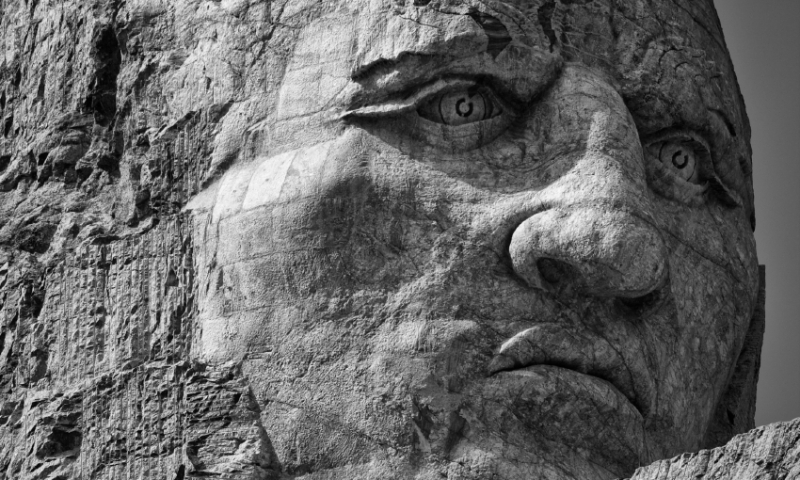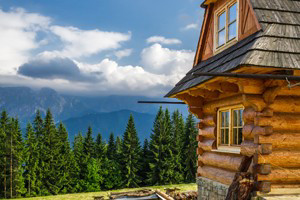What can I see at the Crazy Horse Memorial?
When completed, Crazy Horse Memorial will be the largest mountain sculpture in the world. The site also features a campus including a museum, Native American Education and Cultural Center, the original sculptor’s studio and home, a restaurant, gift shop, and more.
The talented Boston-born sculptor, Korczak Ziolkowksi, was commissioned by Lakota Chief Henry Standing Bear and his tribe to begin work on Crazy Horse Monument in 1948, after settling on a suitable South Dakota mountaintop, with space for adjacent facilities dedicated to the heritage and culture of North American Indians. Crazy Horse Monument became Korczak’s life work, and although he died in 1982, his wife, children, and a group of engineers continue to work on this gargantuan project. The 87 ½ feet tall face was commemorated in 1998 and work is currently being done on the horse’s head. When finished, the monument will be 641 feet in length and 563 feet in height, depicting “a memorial to the spirit” of Crazy Horse as he points over his horse’s head towards the lands where, in Crazy Horse’s words, his “dead lie buried.”
Where is it?
Crazy Horse Memorial is located in South Dakota’s Black Hills, just off HWY 16/385, 17 miles southwest of Mt. Rushmore and 4 miles north of Custer.
When is it open?
- Summer (Mid-May through mid-October)
7 am - 9:30 pm
Legends in Laser light-show begins at dark (starting Memorial weekend).
Laughing Water restaurant summer closing hours 7 pm (mid-May – Memorial weekend) and 8 pm (Memorial weekend – mid-October). - Winter (Mid-October through mid-May)
8 am – 5 pm
After 5 pm, monument parking area open until dark.
There is no set schedule for blasts, however lucky visitors will be notified of such events a few minutes prior and may watch and photograph the explosions.
How much does it cost?
Ongoing memorial construction and facilities operation is dependent upon admission fees and generous individual donations – Crazy Horse Memorial receives no federal or state funding.
- $11/adult OR $28/carload
- Motorcyclists/Walkers/Cyclists - $5/each
- Free admission for children under 6, Native Americans, military personnel w/active-duty ID, Girl and Boy Scout troops in uniform, and Custer County, SD residents.
Leashed pets are welcome.
Who can I call if I have more questions?
Call the park headquarters at (605)673-4681 or Visit their Website.
About Crazy Horse
Chief Crazy Horse was a Lakota Sioux warrior, remembered for his bravery and skill in battle. He led the Lakota through many skirmishes and wars before his life was tragically ended while in the hands of the US army. During his brief life, Crazy Horse exhibited a gentleness and loyalty to his tribe and dedicated himself to the preservation of his people’s culture.
Early Years
- ca. 1840 – 1845: Crazy Horse was born Cha-O-Ha (In the Wilderness), to Oglala Lakota parents, Crazy Horse and Rattling Blanket Woman.
- Cha-O-Ha’s birthplace was near present-day Rapid City, SD.
- Around the age of 12, Cha-O-Ha witnessed the Grattan Massacre on a Brule camp in which the tribe’s chief, Conquering Bear, was killed.
- Following the death of Conquering Bear, Cha-O-Ha’s father took him on his vision quest, near Sylvan Lake, SD.
- Cha-O-Ha’s vision quest involved dreams of himself with a lightning bolt on his cheek, hailstones on his forehead, and a small stone in his ear, while riding a horse.
- After his vision quest, Cha-O-Ha received his father’s name, Crazy Horse.
Warrior and Leader
- At age 16, Crazy Horse rode as an adult warrior in a raid on the Crows.
- Crazy Horse displayed his courage during further battles between enemy tribes, including the Shoshone, Pawnee and Blackfeet.
- 1866: Crazy Horse and other warriors defeated the US army near Fort Kearny in a battle known as the Fetterman Massacre.
- 1867: Crazy horse participated in The Wagon Box Fight.
- Crazy Horse became chief of the Oglala Lakota.
- Crazy Horse married three women: Black Buffalo Woman, Black Shawl Woman, and Helen “Nellie” Laravie.
Great Sioux War of 1876-77: Crazy Horse played an instrumental role in attacks against the US army including:
- the surprise attack against George Crook’s men at the Battle of Rosebud.
- the defeat of Custer’s 7th Cavalry at Little Big Horn.
Surrender and Death
- 1877: Crazy Horse surrendered at Camp Robinson, in exchange for the promise of a reservation for his people near Powder River.
- Rumors soon circulated that Crazy Horse was planning a rebellion which led the government to order his arrest.
- On September 5, 1877, Crazy Horse resisted arrest and was stabbed by the bayonet of a US guard. He died later that night.
- Crazy Horse’s final resting place unknown, however some believe it is near Wounded Knee.
Influence and Memorial
- Crazy Horse’s life and legacy is commemorated at the Crazy Horse Memorial, where visitors can learn more about Native American history and culture and view the enormous sculpture-in-progress of Crazy Horse.
- The United States Postal Service also honored Crazy Horse as part of their Great Americans series of stamps.
About Sculptor Korczak Ziolkowski
Korczak Ziolkowski’s Early Years
September 6, 1908
- Korczak is born to Polish parents, in Boston.
Ages 1 – 20
- Korczak is orphaned at age 1 and grows up in a series of foster homes.
- He shows signs of being a gifted sculptor without formal training and puts himself through Rindge Technical School.
1932
- Korczak completes his first sculpture, a marble carving of Judge Frederick Pickering Cabot.
1939
- Korczak’s sculpture of Ignancy Jan Paderewski wins first prize at New York World’s Fair.
- Korczak is asked to help Gutzon Borglum sculpt Mt. Rushmore.
- Word of Korczak’s talent reaches Lakota Chief Henry Standing Bear.
Crazy Horse Memorial Is Born
1939/40
- Korczak is approached by Chief Henry Standing Bear and other Lakota leaders to construct a mountain sculpture dedicated to the Native American people.
1940 – 1947
- Korczak meets with Chief Standing Bear to discuss possible locations and designs for the memorial.
- The project is put on hold while Korczak volunteers for service during WWII.
May 3, 1947
- Korczak moves to the Black Hills, armed only with a sledge hammer, drill and a box of dynamite. From the onset, Korczak believes that the project should not accept government funding, but should be funded solely by public citizens who, he believed, would see the value in such a memorial and support it with enthusiasm.
June 3, 1948
- The memorial is dedicated to the Native American people following the first blast of many to come in the construction process.
1950
- Korczak marries Ruth Ross, his life-long partner, equally dedicated to the memorial's success.
October 20, 1982
- Korczak Ziolkowski passes away after dedicating 36 years of his life to Crazy Horse Monument. On his deathbed, Korczak’s parting words to his wife Ruth: “"You must work on the mountain-but go slowly so you do it right."
- Korczak is buried in a tomb on the Crazy Horse Memorial site, blasted from rock, with an epitaph on the tomb door that reads: KORCZAK Storyteller in Stone, May His Remains Be Left Unkown
Crazy Horse Memorial After Korczak’s Death
At the time of Korczak’s death, work was still being done on Crazy Horse’s face. Korczak’s wife, his children, and a team of engineers continue work on the enormous sculpture to this day, funded entirely by generous donations.
Over the years, Crazy Horse Memorial’s campus expanded to include a museum, visitors center, educational center and more.
June 3, 1998 – The 88-foot high face was dedicated, exactly 50 years to the day that Korczak began sculpting the masterpiece.
Work is currently being done on the 22-story high horse’s head, and thousands of visitors continue to flock to Crazy Horse Memorial every year, to view this amazing mountain carving and to donate towards its progress and legacy to the Native American people.






